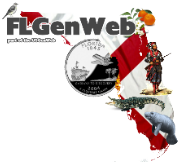|
|
LEE COUNTY
Lee county occupies the southwestern corner of this state. It has an
area of 4,081 square miles, more than four times that of the State of
Rhode Island. Its population in 1890 was 1,414, in 1900 it was 3,071,
and in 1910, 6,294, giving it a density of population of 1.5 to the
square mile.
Included in this area is a considerable portion of the Everglade
section, which contains immense quantities of cypress timber. Lee county
was brought into existence under an act of the Florida State Legislature
of 1887. It was cut off from the county of Monroe, of which Key West was
the center of population. In its early history, Lee county was little
known and its resources were unappreciated, but the vastness of its
territory was its salvation. Although the population was scattering, the
lands were in the hands of large corporations, and the tax revenues from
these financed the necessary government of the county.
In the early days, and continuing until the present time, stockraising
has been a leading industry. In the earlier days of the county, before
it had a separate existence, it was the source of supply for much of
Cuba’s beef consumption and this continued until after the Spanish-
American war in 1898. In former times, some of the largest herds in the
world ranged over its acres, but the gradual breaking up of the arable
lands into smaller farms and plantations is threatening the existence of
stock-raising on the range.
A splendid variety of soil in this county is particularly adapted to the
raising of early vegetables and citrus fruits. Pineapples have been
undertaken on a large scale in Lee county.
Fort Myers, the county seat, is situated on the Caloosahatchee river,
eighteen miles from the gulf. It is an important point in Florida’s
history, having been closely connected with the Seminole Indian wars. It
was garrisoned by United States troops prior to 1850, and about 1857
Gen. Winfield Scott Hancock, then a young
officer, was in command of the fort.
Within recent years, Fort Myers and the surrounding country has become a
winter home of a large number of prominent and influential northern
citizens. Mr. Thomas A. Edison lias here a beautiful winter home, and
many other people almost as well known spend a large share of each year
in this vicinity.
Lee county has a longer coast line than any other Gulf county, and its
waters are alive with many varieties of food and game fishes. More than
two million dollars’ worth of fish were shipped from Punta Gorda under
refrigeration to northern markets in 1912. Its climate is particularly
desirable, and in spite of its extreme southerly location its variations
of temperature through the year are surprisingly small.
Chapin, George M., FLORIDA 1513-1913, Past, Present and Future, Four
Hundred Years of Wars and Peace and Industrial Development, (c)
1914, Vol. 1, Chapter XXX, Florida Counties, pages 592-593
|

.png)


.png)
